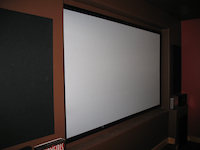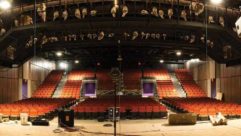

Three Things I Would Do Differently in My Home Theater
Apr 18, 2011 12:00 PM,
by Jason Bovberg

Last July, I wrote an article called “Five Ways to Make Your Home Theater Better Than the Rest,” in which I explored some of the great personal successes that I experienced while building my theater. These successes came after much research and many discussions with my builder. I’ve now been enjoying my home theater for two years, and although I remain very proud of the “wow-factor” features we managed to build into the theater, there are inevitably a few things that I wish we’d done differently. (For background on my home-theater build, see the six-part “Building a New Home Theater” series that begins here.)
Before getting into it, I should express that budget constraints were the real roadblock to some of these things. When we created this theater, we didn’t have the budget for some of the features you might see in photo galleries of the rich and famous. Obviously, I envied that kind of style and AV power, but I didn’t have the Fort Knox finances to accomplish something so extravagant. We simply did the best we could with the amount of cash we had. I’m immensely proud of what we ended up with and the creative solutions we applied to the space. Given that, here are the things I’d do differently if I had to do it all over again.
Acoustical Isolation
In hindsight, we spent an awful lot of time and energy on sound-dampening efforts that really didn’t pay off. My contractor and I did the requisite research on sound absorption, conferring with the drywall and insulation teams about how to best keep the theater’s booming sound inside the theater—rather than radiating upward into my master bedroom, which sat just above the theater. Our final solution was to use hat channel (a steel channel separating drywall from joists) in the ceiling. Compounding this solution, we used Sound Choice sound-deadening fiberboard on the ceiling—underneath the drywall—and my insulation team blew thick cellulose insulation into the ceiling joists in an effort to blunt the transference of high-end sounds upstairs.
In the end, our solution wasn’t enough. Sound flows pretty freely into the bedroom, and there have been nights when I’ve come upstairs after a movie to find my wife in troubled slumber, cramming a pillow against her head. Yes, it’s possible that some of the higher-end sound, such as dialog, has been muted by our ceiling solution, but the deeper bass is unobstructed. The wall studs aren’t protected by a layer of hat channel (only the ceiling is), so the bass inevitably finds its way directly upstairs through the structure. If I had to do it over again, I’d work harder on my original idea of actually creating an acoustically separate room underneath the basement ceiling—in other words, actually framing a room within a room, leaving a gap between the wood beams so that the bass rumblings would be trapped within the confines of the isolated theater.
Projector and Screen Choice
Obviously the choice of a projector is paramount to the success of a home theater, and I really did spend a great deal of time researching the best manufacturers and units for my type of space and conditions. I should have spent more time. Don’t get me wrong, I give my projector a solid A for performance, but I ran into a little annoying detail that I didn’t foresee: My projector—the Mitsubishi HC5500—is particularly vulnerable to dust blobs on the lens, a condition that is even more pronounced in the dry, mile-high climate of Colorado. And these little blobs are impossible to eradicate short of sending the entire unit back to a Mitsubishi service center, which I’ve done twice during the warranty period. My warranty period, however, has just expired, and now I’m a little wary every time I power on the projector, expecting to see the next dust blob appear on the screen.
Three Things I Would Do Differently in My Home Theater
Apr 18, 2011 12:00 PM,
by Jason Bovberg
I’ve taken preventive measures such as inserting a heavy-duty air filter, and even covering that air filter with my own air-filtration cloth. And I even vacuum the filter area clean every third or fourth power-up. I shouldn’t have to do these things, and I shouldn’t have to worry. A little more research might have uncovered these anomalies. All this to say: Spend an inordinate amount of time finding the perfect projection system not only for your theater’s dimensions and idiosyncrasies but for your geographic area! Every theater and wider environment is unique, and there is a projector out there that is ideally suited for your specific requirements.
Screen choice is also a weightier decision that I expected it to be. When I first set up the theater, I went with a recommended grayscale screen, but I quickly saw that in a fully dark room, that was a bad idea that significantly darkened the projector’s image. In my black “screening room” type home theater, I needed a bright white screen, so I quickly upgraded—at a not-insignificant price. So, be sure to determine what screen type best suits the kind of theater you’ll have, whether that’s a pure dark “movie theater” or an open-environment “entertainment area.”
Sound Dampening
While building the theater, I admit to being more concerned with features I wanted to include—the custom media shelves along one wall, movie posters here and there—than with the effect of these features on the transmission of sound. Those media shelves contain a whole lot of sound-reflecting DVD and Blu-ray cases, and sometimes I wonder about the effect they’re having on my audio presentation. I don’t want the majority of one wall to be absorptive while the other remains completely reflective.
This is not something that I notice in day-to-day viewing, but occasionally I’ll detect something slightly off in the audio, and I’ll wonder if I should have better researched some kind of audio-equalizing solution. The overriding problem is that the room itself is oddly shaped: A doorway to the left of the screen adds a sort of vestibule, and I still don’t know how audio is moving in that space.
This is one area where I’ll admit to remaining ignorant: Sound dampening and directing has always seemed to be an optional step. Or, at least, as long as I didn’t do something crazy like blanket all the walls with sound-muting fabric (I’ve done this in the past!) or leave every surface absorptive, I considered myself generally in the clear. Bottom line: I wish I’d looked into it a little more. And I recommend that you do so. Be kind to your speakers and your ears.
Be Smart
Yes, it would have helped if I’d had a fatter wallet while building my theater, but when it comes down to it, I probably would have saved money in the long term by simply doing a little more research—particularly on those technologies that I know nothing about! So read articles and watch for forum discussions about every aspect of the theater you envision—saving money, time, and aggravation is a Google search away.










